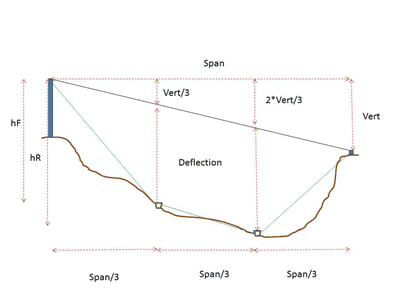Deflection is an indicative measure of payload capability for a skyline system. It is the vertical distance between the skyline and the chord joining the top of the tower and the top of the tailhold. It is normally expressed as percent of the span between the tower and the tailhold. All other things being equal, the bigger the deflection percent the larger the payload capability.
Two approaches for calculating deflection are provided in CHPS; midspan deflection and 3-point deflection. Midspan deflection is the more common approach.
Deflection is an indicative measure of payload capability for a skyline system. It is the vertical distance between the skyline and the chord joining the top of the tower and the top of the tailhold. It is normally expressed as percent of the span between the tower and the tailhold. All other things being equal, the bigger the deflection percent the larger the payload capability.
Two approaches for calculating deflection are provided in CHPS; midspan deflection and 3-point deflection. Midspan deflection is the more common approach.

Midspan Deflection (%) = 100*Deflection/Span
where for the figure shown above:
•Span is the horizontal distance between the tower and the tailhold.
•h is the vertical distance between the top of the tower and the carriage at midspan.
•Vert is the vertical distance between the top of the tower and the top of the tailhold.
•Deflection is the vertical distance between the chord and the carriage at midspan and is equal to: h - Vert/2
In CHPS, 3-point deflection calculations are based on a single span, live skyline system assuming zero suspension at either one-third span or two-thirds span.

3-Point Deflection (%) = 100*Deflection/Span
where for the figure shown above:
•Span is the horizontal distance between the tower and the tailhold.
•hF is the vertical distance between the top of the tower and the carriage at one-third span.
•hR is the vertical distance between the top of the tower and the carriage at two-thirds span.
•Vert is the vertical distance between the top of the tower and the top of the tailhold.
•Deflection is the minimum vertical distance between the chord and the carriage at either one-third span or two-thirds span and is equal to: min( [hF - Vert/3], [hR – 2*Vert/3] )